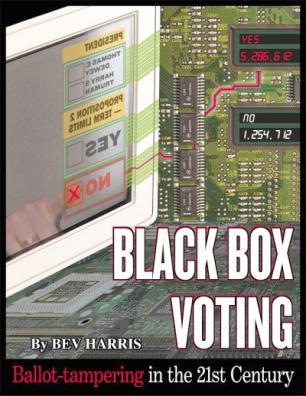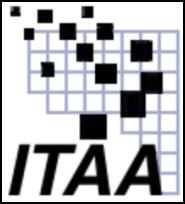In This Edition: SAIC Connected To E-Voting Whitewash - $$$$$s To Clean Up E-Vote Stink - ITAA eVoting Industry Coalition DRAFT Plan, Activities, and Pricing - For More Information
Sludge Report #156
SAIC Connected To E-Voting Whitewash
See also...
- Sludge #157 – The ITAA, The Election Center & R. Doug Lewis
- & Watch for breaking news on this Scoop at blackboxvoting.com

http://www.blackboxvoting.com
Read The Book…Support The Cause
Pre-Order Your Copy Today
On the board of the Enterprise Solutions Division of the Information Technology Association of America (ITAA) – a lobbying organisation bidding to provide a $200,000+ public opinion manipulation campaign on electronic voting – is a senior vice president of SAIC, the company tasked with investigating the security of the Diebold voting machine technology in the states of Maryland and Ohio.
The revelation that Ronald J Knecht, Senior Vice President, SAIC, and a former defence intelligence chief, is connected to the proposed voting machine whitewash push seems certain to fuel public concerns about the number of conflicts on interest in the voting machine industry.
SAIC has been tasked by the Governor of the state of Maryland to report on security concerns around Diebold Election Systems software and hardware..
To date in the developing story about electronic security concerns about new touch screen voting systems – black box voting – high profile conflicts of interest have already caused problems for 1) Nebraska Republican Senator Chuck Hagel and 2) for Johns Hopkins university professor Avi Rubin, co-author a report damning Diebold's touch screen software security published in June.
$$$$s To Clean Up E-Vote Stink
The document that follows is a confidential internal memo, and is published here as intended source material for the numerous US media presently pursuing the Diebold FTP Files story broken here on Scoop. (See… Google Breaking Headlines - Wired – Ohio – New York Times – MSNBC )
It provides a rare glimpse into the insides of a major corporate United States emergency PR operation being run at full throttle.
In particular it reveals the plan prepared by the Enterprise Solutions division's Michael Kerr for the ITAA – an organisation funded and representing many of the biggest defence contractors - to clean up the public impression left by recent revelations concerning the hackability of Diebold Elections Systems software. Diebold's software source code was left by the company on an open to the public insecure FTP website and downloaded by investigators including Seattle's Bev Harris.
The whitewash proposal has been coordinated in association with the Election Center – a seemingly chimerous body coordinating Secretaries of State in the United States and which works closely with the body tasked with certifying the electronic voting machine certifiers.
This morning by phone Voting machine companies from all over the United States (and remember this is a NZD$8 billion + market) were asked for $200,000, to provide a full service public relations assault. It includes proposals to retain a pet think tank and for funding public opinion polls to press the agenda of the manufacturers that electronic voting machines are safe for democracy.
The document proposes to aggressively sell the notion that voting via a computer is the "gold standard" for any democracy to aspire to.
Significantly the plan does not suggest the voting industry convene a group to actually make computer voting the gold standard, though it does suggest cooperation on –non-competitive issues. Rather the clear thrust of the proposal is to simply finance the creation of a public impression of safety.
Also significantly, no mention in the document is made of "Verifiable Paper Trails" a cheap and effective solution to the problem of potentially hackable electronic voting machines backed by a growing group of eminent computer scientists led by David Dill of Stanford University.
This morning in the phone conference. Details of which will follow in subsequent report. One participant commented that if David Dill was involved in the efforts to influence the standards, "I'm sure noone would want to play."
**********
See below…
… for the full text of a public relations campaign proposal to clean up the Diebold E-voting stink proposed by the Information Technology Association of America (ITAA) to players in the multi-billion dollar voting machine manufacturing business today.
The proposal was written by Michael Kerr of the Enterprise Solutions division of the ITAA on Wednesday. It calls for commitments of up to USD$200,000 by August 29th, next Friday.

ITAA
eVoting Industry Coalition
DRAFT Plan, Activities, and
Pricing
Purpose: Create confidence and trust in the elections industry and promote the adoption of technology-based solutions for the elections industry. Repair short-term damage done by negative reports and media coverage of electronic voting. Over the mid- to long-term, implement strategy that educates key constituencies about the benefits of public investments in electronic voting, voter registration and related applications.
Audience: Public confidence in the integrity of the ballot box is absolutely critical to the democratic process. To build such confidence, the vendor community must address several constituencies:
1. Media
2. Elected officials at the
federal, state and local level
3. Elections
administrators, procurement officials and others involved in
the purchase decision
4. Academia
5. General
public
6. International counterparts
7. Systems
integrators and related government contractors
Success Benchmark: Achieve widespread acceptance among
key constituencies that electronic voting is not just an
alternative to other balloting systems, but is the "gold
standard" to which all should aspire.
Model
1
Goals:
1. Help assure the integrity of
IT used in the electronic voting process
2. Generate
positive public perception of the eVoting industry
3.
Speak with a unified voice on industry standards
4.
Develop liaison with key constituencies in order to build
broader support for e-voting
5. Improve security of
technology and development/deployment processes
6.
Improve public awareness of voting technology security
7.
Reduce substantially the level and amount of criticism from
computer scientists and other security experts about the
fallibility of electronic voting systems.
8. Adopt an
industry code of ethics
Generate collaborative research on non-competitive issues
Major Activities:
Deliverables
1. Establish Blue Ribbon Task Force to evaluate voting technology development and implementation processes, propose process improvements, and establish code of ethics.
2. Produce and publish collaborative research on non-competitive issues - 2 annual white papers.
3. Assess public attitudes about electronic voting on a regular basis through public opinion surveys, focus groups and other research.
4. Hold seminar/briefings/webcasts on Blue Ribbon Task Force findings, code of ethics launch, white paper releases.
5. Create comprehensive media plan to articulate key messages, identify outreach strategy and tactics, synchronize timing of media outreach to election milestones and other significant events, and raise visibility of issues, activities and the ITAA Election Systems Task Force itself.
6. Develop liaison to national
associations, government oversight bodies, customer trade
associations
a. Attend national conferences, work to add
agenda items to programming
b. Arrange guests at
briefings, monthly meetings, receptions
c. Arrange
meetings with key government executives, lawmakers,
staff.
7. Provide customer interface opportunities
a.
Arrange guests at briefings, monthly meetings
b. Develop
a regular dinner, reception program.
Regular
Meetings/Events
1. Hold monthly meetings in Washington D.C. or Dallas area
2. Hold bi-annual full membership meetings
Fees in addition to annual dues:
$100,000 - $125,000
Model 2
Goals:
Same as Model 1.
Plus: Perform a detailed evaluation of voting technology security standards and certification processes.
Major
Activities:
Deliverables
1 - 7. Same as Model 1.
8. Retain consulting firm or think tank for review and evaluation of voting technology security standards and certification processes. Publish findings/recommendations.
Meeting/Events
1. Hold monthly meetings in Washington D.C. or Dallas area
2. Hold bi-annual full membership meetings
Fees in
addition to annual dues: $125,000 -
$150,000
Model 3
Goals:
Same as Models 1 and 2.
Plus: Perform a detailed evaluation of voting technology security standards and certification processes.
Plus: Re-engineer voting technology security standards and certification processes, based on findings in report.
Plus: Build media, public, and customer awareness of new security and certification processes.
Major Activities:
Deliverables
1 - 7. Same as Models 1 and 2.
8. Retain consulting firm/think tank for review and evaluation of voting technology security standards and certification processes. Publish findings and recommendations.
9. Implement report findings/recommendations; re-engineer security standards and certification processes.
10. Launch public relations campaign to build media, customer, and public awareness of new security and certification processes.
Meeting/Events
1. Hold monthly meetings in Washington D.C. or Dallas area
2. Hold bi-annual full membership meetings
Fees in
addition to annual dues: $200,000+
Schedule
With the Iowa caucuses (and therefore the start of the primary season) only five months away, time is exceedingly short to implement this plan. Americans must have full faith in the efficacy of the election systems infrastructure. Numerous factors, including the overarching need to conduct the 2004 election with no “hanging chad” controversies, suggest that work commence with a minimum of delay.
ITAA recommends the following schedule of major milestones to bootstrap this effort:
August 29 ITAA
membership applications have been completed by the core
group of election
systems companies
September 3 Election Systems Task Force conducts teleconference to review and refine plan
September 12 Plan is approved, work groups established and implementation begins
September 22 Invitations tendered to candidates for “Blue Ribbon” Board; media plan circulated
September 30 First public opinion survey goes into field
October 14 Launch event to report survey findings, announce task force, blue ribbon board
Conclusions
ITAA is ready, willing and able to work with firms in the election systems sector to build and, as necessary, restore, a high degree of confidence in the integrity of e-voting and related applications. ITAA provides an ideal forum to undertake this program, offering:
1. a sophisticated government
affairs and public relations apparatus;
2. over 20 years
of industry engagement in public sector contracting;
3.
the premier trade association membership of contractors
involved in the federal systems marketplace;
4. an
on-going state and local advocacy program;
5. an
existing Election Systems Task Force and internal staff
resources well schooled in the underlying issues;
6. and
a track record of lobbying for federal funding to upgrade
state and local electronic systems.
ITAA applauds the companies involved at the Election Center meeting for having the vision and determination to address the current doubts about election systems on an industry basis. Working together, ITAA believes that these companies have already taken the first step to meeting the common challenge.
For More Information
For more media resources and links concerning the ITAA, The Election Center and R. Doug Lewis the proponents of this campaign - see the following companion Sludge Report. See also http://www.blackboxvoting.com http://www.blackboxvoting.com for more breaking making news on this subject.
Anti©opyright Sludge
2003



 Martin LeFevre - Meditations: True Abundance
Martin LeFevre - Meditations: True Abundance Binoy Kampmark: Junk Science And Bad Policing - The Homicide Prediction Project
Binoy Kampmark: Junk Science And Bad Policing - The Homicide Prediction Project Keith Rankin: Rational Expectations, Intelligence, And War
Keith Rankin: Rational Expectations, Intelligence, And War Peter Dunne: Dunne's Weekly - Is Andrew Little Wellington's Mayor-In-Waiting?
Peter Dunne: Dunne's Weekly - Is Andrew Little Wellington's Mayor-In-Waiting? Gordon Campbell: On Peter Dutton’s Fading Election Prospects.
Gordon Campbell: On Peter Dutton’s Fading Election Prospects. Binoy Kampmark: Withdrawal Symptoms - Hungary, Europe And The International Criminal Court
Binoy Kampmark: Withdrawal Symptoms - Hungary, Europe And The International Criminal Court